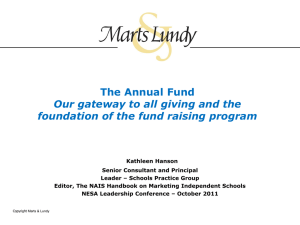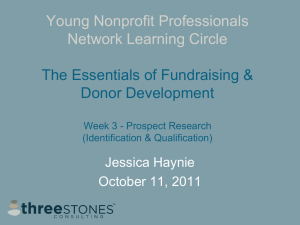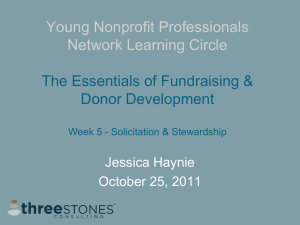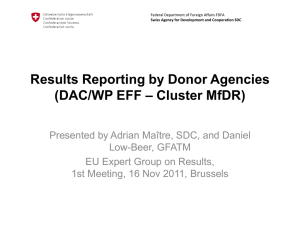DonorCast - Minnesota Planned Giving Council
advertisement
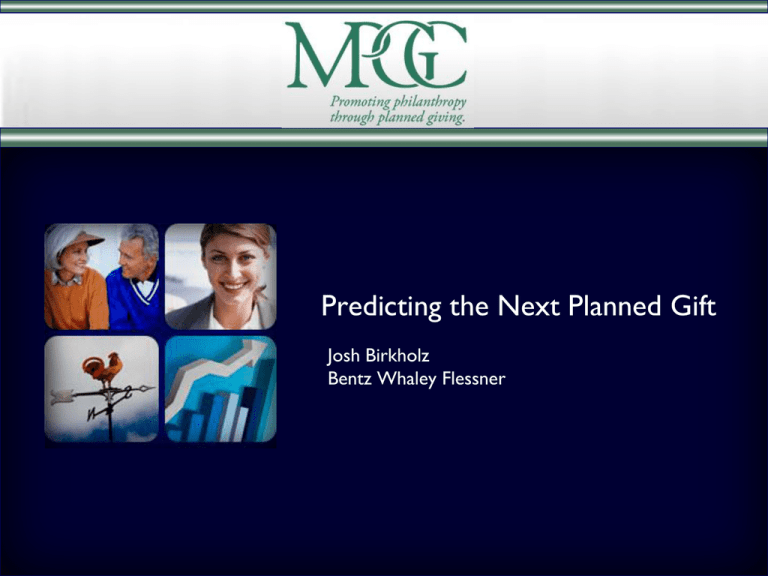
Predicting the Next Planned Gift Josh Birkholz Bentz Whaley Flessner Bright Spots 1 Plan Setting the stage Introducing How Predictive Analytics. is it accomplished? Just One Statistical Principle: Randomized Testing Bringing 2 Analytics In-House Setting the stage 3 Fundraising Has Three Primary Business Processes Base Development One-to-many strategies of engagement Major/Planned Gift Development One-to-one high ROI strategies Prospect Development Conversion from base to major Prospect Development has Three Stages Feeding Major and Planned Gift Cultivation Market Research Identification with screening and modeling Prospect Research Qualification with data Field Research Discovery / qualification through interaction Plan Strategy Stewardship Major Gift Fundraising Cycle Solicitation 5 Cultivation Effective Prospect Development for Planned Giving Identifies - prospects meeting the criteria planned gift donors. Traditional characteristics Characteristics unique to your organizations Works with fundraisers to develop strategies for aligning the prospects with the institution for a philanthropic partnership. Characteristics Assumptions Observations Consistent Assumptions Old donors donors Donors assets with appreciated generally accurate for most institutions. Other common characteristics from our research: Legacy families Multiple property owners Employment in education and public service Donor loyalty Positive 7 donor experience How is Loyalty Achieved? Needs + Needs met consistently = Loyalty Example: Positive Donor Experience 9 Introducing Predictive Analytics 10 What Is Meant by “Analytics?” Analytics describes the statistical tools and strategies for: Analyzing constituencies. Building models to predict constituent behaviors. Evaluating program performance using relevant metrics. Projecting 11 future program performance. Analyzing Constituencies Identifying Defining core constituent groups. their characteristics. Understanding their motivations. Applications 12 Portfolio optimization. Segmentation strategies. Event programming. Data Mining and Predictive Modeling: What Is “Data Mining?” Using statistics to identify patterns in data. Comparing characteristics of people or things doing a behavior with people or things not doing the behavior. 13 Data Mining and Predictive Modeling: Predicting Behaviors from the Patterns Common - 14 non-fundraising examples: Credit ratings Meteorology Airport security Modeling Can Predict Many Things Major, planned, and annual giving Program or department models. (giving to fine arts, capital needs, scholarships, patient care, etc.) Membership likelihood Season ticket subscriptions Alumni affinity Channel preferences (mail, phone, email) Next gift amounts Loyalty scoring with precise weightings 15 Effective for Planned Giving: Your constituents compared to Your success stories using Your data to identify Your unique opportunity 16 How is it accomplished? 17 Method 18 Understand your goals before you begin. Gather your data. Included demographics, giving, research, and screening data. Prepare the data for modeling. Model. Evaluate the results against existing donors and prospects. Score the file and implement the results. Common Score Format (Fractional ranking displayed) All records have a ranking and a 0–1,000 score. Planned Giving Rank Label Minimum Maximum 4 500 1 Top 50% 500 750 2 Top 25% 750 900 3 Top 10% 900 950 4 Top 5% 950 975 5 Top 2.5% 975 990 6 Top 1% 990 995 7 Top 0.5% 995 997 8 Top 0.25% 998 999 9 Top 0.1% 999 1,000 0 Lower 50% 19 Planned Giving Score 20 PG Donor Not PG Donor 9 Top 0.1% 8 Top 0.25% 7 Top 0.5% 6 Top 1% 5 Top 2.5% 4 Top 5% 3 Top 10% 2 Top 25% 1 Top 50% 0 Lower 50% Percentage Evaluate by Comparing Scores to Actual PG Donors 100 80 60 40 20 0 Categorize Variables From Output Giving Geography Demographics Management Capacity 21 Sample of Possible Variables in Your Model Category Variable Length of Giving Relationship Giving Frequency Index Monthly Payment Preference Capacity Multiple Property Ownership >100 miles from campus Geography Wisconsin (-) 55439 (+) Event Attendance (+) Management Survey Response (+) Alumni Volunteer(+) Demographics 22 Education Job Title(+) Single(+) Opportunity: Review Portfolio, Prioritize Direct Marketing Appeals Planned Giving Model Rank 23 Not Assigned a Prospect Manager Managed 0 Lower 50% 53,425 92 1 Top 50% 26,507 257 2 Top 25% 15,330 724 3 Top 10% 4,767 585 4 Top 5% 2,201 474 5 Top 2.5% 1,197 410 6 Top 1% 326 208 7 Top 0.5% 129 139 8 Top 0.25% 59 101 9 Top 0.1% 20 88 Examples: Successful Implementation New planned giving director. Prepared new prospect list. Felt it was a “stacked deck.” 24 Program needed jump-start. Purchased predictive models. Aggressively marketed and discovered new names. Had best planned giving year in history. Just One Statistical Principle: Random Testing 25 Drawing Planned Giving Donors Out of a Hat Imagine a hat with 130 slips of paper. About 31% of the slips have the words “planned giving donor” written on them. If you draw a slip out of the hat, approximately 1 in 3 will be a PG donor. For most organizations, planned giving donors represent a far lesser portion (<5%). Can We Improve This Ratio? We could survey our actual planned giving donors asking: How - - would you describe yourself? A blue slip of paper A green slip of paper A yellow slip of paper Survey Results Now Which Slip of Paper Will You Select? If You Choose Blue… Will you draw a planned giving donor on average 1 out of 2 times? The Answer: Unknown There You 30 is not enough information. do not know the distribution of the random population. Consider Your View Now, which slip will you select? Total Count % of Total PG Donors % of PG Donors % of Color that are PG Donors Blue 60 46% 20 50% 33% Green 60 46% 12 30% 20% Yellow 10 8% 8 20% 80% 130 100% 40 100% 31% Population Total 33% 67% 1 in 3 1 in 5 4 in 5 Principle Common characteristics may not be distinguishing characteristics. How populations are different (target vs. random) is more interesting statistically and predictive than common characteristics of a target group. 32 Bringing Data Mining In-House 33 Bringing Data Mining In-House More and more organizations have in-house data mining capacity, from large shops to small shops. Large shops generally have dedicated staff. Small shops have developed the skill sets in research, advancement services, or annual giving. 34 Making the Case Gather references of peers and aspirant peers. Build a cross-functional project team. Start with short-term projects—specific appeals. - Communicate goals before the project. Communicate the success after the project. Educational - 35 and research institutions: Explore on-campus knowledge resources (economics, statistics, business departments). Explore on-campus software resources. Statistics Software SPSS - - SAS - Very powerful for large data sets Needed for regulatory testing (not necessary in fundraising) Good network of researchers using SAS DataDesk - - 36 My personal preference User friendly for expert and novice alike Large network of other researchers using SPSS Object-oriented format easy to understand Excellent for exploratory analysis Large network of other researchers using DataDesk Training Software training courses Conferences and users groups Learning through outsourcing (you are buying methodology as well as analysis) Onsite consulting Campus 37 resources Learn Through Outsourcing Many organizations outsource their analytics; benefits include: Expert analysis. Opportunity High 38 to learn from their methodology. level of service over the short term. Developing In-House Capacities It is not hard to learn. Analytics is becoming part of the constituent relations and admissions skill set. Nobody Ability knows your data like you do. to create multiple models and analysis—not to be restricted by costs. 39 Final Thoughts 40 When You Leave Today, Remember: Start with your bright spots. Build a prospecting plan around your characteristics. Consider predictive analytics to identify and prioritize your list. Comparing PG donors to random donors is more valuable than summarizing common PG donor characteristics. Whether you outsource or build analytics in-house, analytics is within your reach. 41 Questions? Joshua Birkholz Principal, Bentz Whaley Flessner Founder of DonorCast 89646:JMB:abl:050410. 7251 Ohms Lane Minneapolis, Minnesota 55439 ph: 952-921-0111 fax: 952-921-0109 jbirkholz@bwf.com www.donorcast.com


